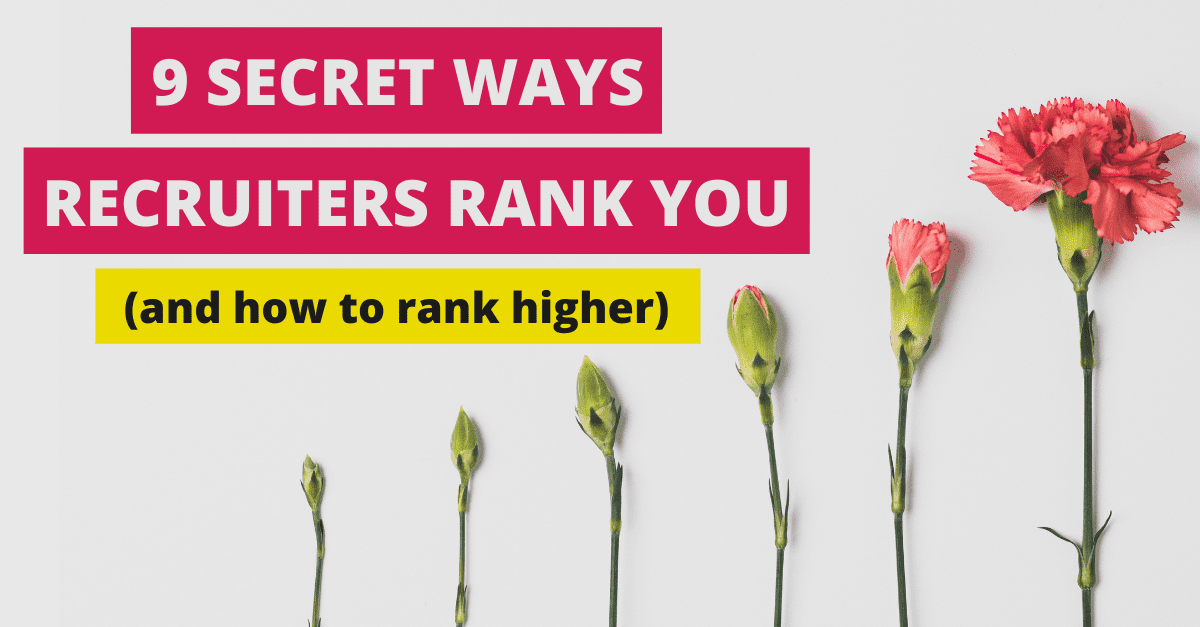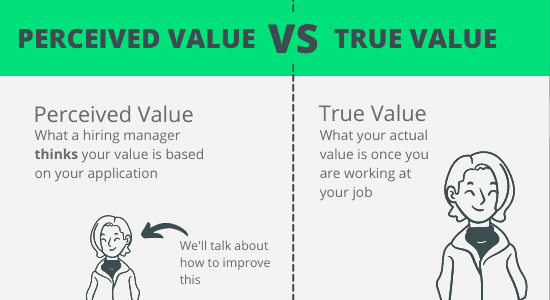
9 Secret Ways Recruiters Rank You as a Job Candidate (and how to rank higher)
Not all candidates are viewed equally in the eyes of a recruiter. Surprisingly though, sometimes that your value isn’t actually based on your resume or past experience.
Job search expert, Kevin Wheeler, recently wrote an eye-opening commentary about how some recruiters actually judge candidates based on their source and employment status.
This "perceived value" may be hurting your job application.
But there is good news here: there are ways to get around some of these perceptions.

To be clear, your actual value has nothing to do with your perceived value. In fact, in many cases your actual value is a lot greater. But, in order to actually get the job and show your actual value, you’ll need to get your perceived value higher.
This is especially important if you’re currently unemployed, as your perceived value might be much less than your actual value. But, even employed candidates suffer from the biases we will cover below.
Basically if you’ve ever thought: “if they would only give me a chance I could show what I can do,” keep reading.
In this post we’ll break down the 9 secret ways recruiters rank different types of candidates based on source and status. At the end we’ll also share a few ways you can stand out as a candidate, regardless of where you apply or what your employment status is.
(NOTE: Not all recruiters rank candidates this way. Some recruiters make great efforts to remove bias from their decisions and they are amazing for doing so! This post covers how to overcome those "not-so-consiencious" recruiters)
How Recruiters Rank Candidates
In a recent poll, recruiters were asked how they perceive a candidate based on where they found that candidate and what that candidates status is. Some results were pretty self explanatory, like a happy employed candidate is more desirable than an unhappy unemployed candidate.
But, there were some interesting rankings in between these two extremes. Here are the 9 different types of candidates, in order from most promising to least promising, in the eyes of the recruiters.
1. Current Employee
The recruiters who were surveyed claim that their best hires come in the form of internal hires that are currently at the company. This makes sense since these employees are proven “results-makers” who are already familiar with the politics and culture of the company. Recruiters believe a current employee will be the most productive and hold a longer tenure.
2. Employee Referral
According to recruiters, the next-best potential hire comes from an employee referral. A current employee in the company usually holds some clout, their word carries weight. That’s why anyone they're referring to an open position is perceived as a better culture fit with longer tenure.
Culture fit and relationships between coworkers are highly valued by recruiters. If a new hire doesn't mesh well with the current team, they're likely to quit relatively soon. One survey found that 31% of the 1,000 workers surveyed quit their jobs in their first six months. That’s why when recruiters are looking to hire they’re looking for someone who will mesh well with the existing team.
3. Former Employee
Recruiters consider a former employee to be slightly less desirable than an employee referral. This is because they know how the company operates and what its policies are. They also likely still have internal relationships with past managers or teammates. This means that the time it takes to onboard them and turn them into a fully productive employee is far lower, making them more desirable as a candidate.
4. Current Intern
While slightly less desirable than a former employee, according to hiring managers and recruiters, current interns still understand the company culture. The company has already seen how this person meshes with the rest of the team and they also know their level of expertise. Recruiters believe they'll likely continue to be productive members of the company after converting to full-time and this again decreases the time it takes to onboard this person into a fully productive employee.
5. Competitor’s Employee
Recruiters view the employee of a competitor as a good candidate because this person has industry knowledge and also brings with them some competitive intelligence. They know what the competitor did that worked well and what they did that performed poorly. Recruiters say that these employees can help fill in blind spots on a team.
6. Vendor’s Employee
A vendor’s employee refers to an employee who works at a company that the recruiter’s current company uses.
For instance, if Salesforce is looking to hire a marketer, they might look for current employees of the marketing vendor they currently use. That candidate is likely familiar with Salesforce and has more appropriate industry experience than a marketer from an agricultural company or an insurance company, for example.
7. Employed - Passively Job Searching
The next most desirable candidate is someone who is employed and isn’t job searching. This candidate is likely happy with their job, which means they are probably a good team player, coworker, and employee.
8. Employed - Actively Job Searching
An actively searching, employed candidate is still involved in the workforce and, presumably, increasing their industry knowledge. They’re staying up-to-date with the latest trends in their field and their skills aren’t going stale.
The reason that these candidates are ranked below passively searching candidates is because it’s unclear why they’re leaving their current job. Maybe they don’t get along with their coworkers? Maybe they don’t like staying at a job for very long?
9. Unemployed - Actively or Passively
These final two categories of candidates aren’t desirable for any reason and for the most part being unemployed doesn’t have any benefits in the eyes of a recruiter. Furthermore, unemployed candidates can sometimes be perceived as “out of touch.” In some cases being unemployed also raises questions of, “why are they unemployed? Is it because they don’t get along with their coworkers? Maybe they’re rebellious and not a team player?”
Is This Data Correct?
As we touched upon previously, this data regarding the different types of candidates is incorrect. There is no evidence to show that employed candidates are actually better than unemployed candidates.
The correlations aren’t real, but the perceptions are.
Nonetheless, the reason these trends are so pervasive is because, as humans, we tend to see patterns that fit our pre-existing beliefs.
This means if a recruiter makes a great hire from a desirable candidate, that stands out in their memory. Conversely, if they make a great hire from an undesirable candidate, that generally gets forgotten.
Unfortunately, even though these correlations are misguided, they exist and continue to drive recruiters' and hiring managers' decisions.
So, since we can’t change these perceptions, at least we can use them to our advantage.
Here's how you can circumvent these categories, no matter where you fall in the arbitrary ranking.
How to Get Recruiters to Find You More Desirable
Currently Employed
The best way to apply to jobs involves referrals. Remember that referred candidates are second on the list after current employees.
Getting a referral is a tricky process if you aren’t sure what you’re doing. You’ll need to network your way in strategically. We created this guide on networking for a job that shows you a proven method for securing referrals.
If networking isn’t your cup of tea, however, another way you can take advantage of these stereotypes is by applying to companies who are competitors or vendors.
Currently Unemployed
If you’re currently unemployed, your best option is still to try to land a referral. While you’re networking your way into a referral, there are a few other things you can do to get an advantage.
One way to get an advantage is by applying directly on a company’s website. According to Teresa, a recruiter we spoke with, candidates who apply through a company’s website are more desirable.
“I always check the candidates that have applied through our own website before I check the candidates from LinkedIn or job boards. They’re usually more familiar with our company and I know they’ve at least looked at our website.”
You can still scan job boards, but then try to find those same job listings on the company's website and apply directly.
If you can’t find the posting listed on the company’s site, you can still apply on the job board itself. Your best bet though is to use the highest-quality job boards rather than just any job board.
One last way to gain an advantage is to make sure you put your best foot forward when speaking with companies. This means you shouldn’t lead with the fact that you’re unemployed. You can learn how to navigate this question and others in our Interviewing for Introverts course.
Next Steps
Regardless of where you land on the spectrum of “desirability,” it’s important to remember that the value someone sees in you is not a reflection of your true value. No matter who you are or what you do, you do have value.
It’s easy to forget that when you’re applying to job after job and not hearing anything back. That’s why it’s so important to tap into resources like great career coaches or join a community like our Job Hackers Group where you can get feedback on what you’re doing.
Once you increase your perceived value, doors will start opening, it’s just a matter of studying up and surrounding yourself with other valuable people and mentors.
Read more resume, LinkedIn, and interview best practices on The GHYC Blog.
------
Author: Caroline Mameesh is a freelance writer and recent Cornell graduate with a passion for helping people navigate their careers. She loves to write about a variety of topics. When she isn't writing, she's coaching students and young professionals on careers in startups. To learn more, visit her website.
Get 1-on-1 Help
Need to land your job ASAP? Fast forward your job search with some 1-on-1 help! 👇
More from the blog:

Best Resume Builders of 2023 (Pros & Cons + Prices)
Modern resume builders use AI, ATS-friendly templates, and active recommendations to help you build your perfect resume faster than ever before. In this post we’ve rounded up the 5 best resume builders of 2023.
How to Beat the ATS in 25 Minutes | The Ultimate Guide
In this guide I’ll show you how to beat the ats (applicant tracking system), plus I’ll give you 2 ATS-friendly resume templates and a free tool to test if your resume is ATS-friendly.
Like this? Try our free courses!
Tired of sending your job applications into a black hole and never hearing back? Get hired faster with our guided courses all for FREE!
Bogdan Zlatkov is the Founder of GHYC and author of "The Ultimate Guide to Job Hunting", ranked #1 on Google. He has been featured in the Wall Street Journal, Fast Company, HR Dive, and more. At GHYC, Bogdan creates job search courses & tools by working with award-winning career coaches, best-selling authors, and Forbes-Council members. Prior to GHYC, Bogdan led the content programs at LinkedIn Learning.